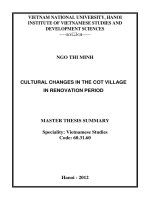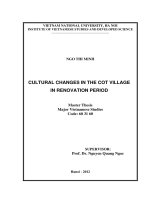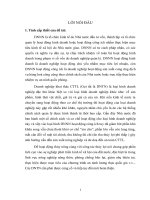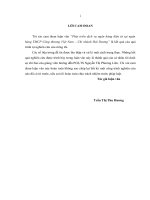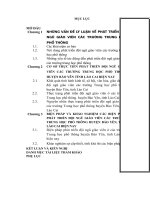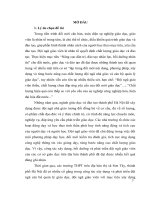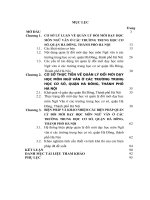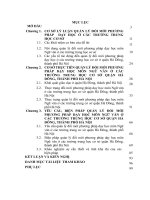- Trang chủ >>
- Cao đẳng - Đại học >>
- Luật
(Luận văn thạc sĩ) những biến đổi văn hóa ở làng cót thời kỳ đổi mới luận văn ths việt nam học 60 31 60
Bạn đang xem bản rút gọn của tài liệu. Xem và tải ngay bản đầy đủ của tài liệu tại đây (1.2 MB, 110 trang )
VIETNAM NATIONAL UNIVERSITY, HA NOI
INSTITUTE OF VIETNAMESE STUDIES AND DEVELOPED SCIENCE
-----------------------------------------------------
NGO THI MINH
CULTURAL CHANGES IN THE COT VILLAGE
IN RENOVATION PERIOD
Master Thesis
Major Vietnamese Studies
Code: 60 31 60
SUPERVISOR:
Prof. Dr. Nguyen Quang Ngoc
Hanoi - 2012
ACKNOWLEDGEMENT
After a period of time researching and implementing of specialized master's
thesis majored Vietnamese Studies, the thesis: "Cultural changes in the Cot village in
renovation period“ has been perfected and completed.
First of all, in order to get the desired results, I would like to express my deep
gratitude to Prof. Dr. Nguyen Quang Ngoc – the Director of Institute of Vietnamese
Studies and Developed Science, who is my supervisor for this master thesis, for his
kindness and willingness as well as valuable advices and science-oriented guidances
that help me well in conducting this thesis.
Moreover, as this Master thesis marks a completion of studying process at the
IVS&DS, I also would like to show my great gratitude to my lecturers and professors
who taught us at class CH-K4 for advanced studies majors as well as to all the staff of
the Institute.
Secondly, I truly appreciate the enthusiastic contribution of People Committee
Cau Giay district, People Committee of Yen Hoa ward, families and individuals
living in Yen Hoa ward, who are extremely willing to give me figures, interviews
and local data surveys for improving this thesis.
Thirdly, my acknowledgement is included here to the leader of Training office
– Hanoi College of Education as well as the staff, colleagues, who gave me a great
cares, encouragements and willing to help me all the time
And finally, I would like to send my all-heated thanks to all of my teachers as
well as friends, who always gave me supports so that I could get over all the
diffculties during the research.
Despite my best efforts, due to the limitation of my capacity, the time... the
thesis could not be avoided inevitable shortcomings; I am looking forward to
receiving the valuable comments of all so that I could overcome the limitations as
well as develope my thesis in the next researches.
Sincerely yours,
The thesis’ author
Ngo Thi Minh
CONTENTS
OPENING ..................................................................................................................1
1. Purpose and the meaning of the subject ..................................................................1
2. Historical research issues .......................................................................................2
3. Objects and scope of research topics ......................................................................7
4. The resources and research methods .......................................................................8
5. Contribution of the thesis ......................................................................................10
6. Layout of the thesis ...............................................................................................11
CHAPTER 1: THE NATURAL CONDITIONS, THE
FORMATION AND CHARACTERISTICS OF THE TRADITIONAL COT
VILLAGE ................................................................................................................12
1.1. Geographical location and natural conditions ..............................................12
1.1.1. Geographical location ................................................................................12
1.1.2. Topography and soil ...................................................................................13
1.1.3. The transport system ...................................................................................15
1.2. Village formation process and the administrative changes..........................16
1.2.1. The process of formation ............................................................................16
1.2.2. Evolution of the village administration ......................................................18
1.3. The features of traditional Cot village ..........................................................21
1.3.1. Cot village - an ancient Vietnamese village, situated at the gateway to the
west of the capital .................................................................................................21
1.3.2. Cot village - land rich tradition of innovation ...........................................21
1.3.3. Cot village - land of rich cultural traditions ..............................................23
1.3.4. Patriotic tradition against foreign aggression and fighting spirit
indomitable resilience ...........................................................................................26
State the chapter 1 ...................................................................................................28
CHAPTER 2: CULTURE COT VILLAGE BEFORE
THE RENEWAL PERIOD ....................................................................................30
2.1. Socio-economic situation .................................................................................30
2.1.1. The period from 1945-1954 ........................................................................30
2.1.2. The period from 1954-1975 ........................................................................31
2.1.3. The period from 1976-1986 ........................................................................37
2.2. Cultural situation .............................................................................................39
2.2.1. Spiritual cultural .........................................................................................39
2.2.2. Material culture ..........................................................................................43
State the chapter 2 ...................................................................................................46
CHAPTER 3: CULTURE COT VILLAGE RENEWAL PERIOD TO THE
PRESENT ................................................................................................................47
3.1. Socio-economic situation .................................................................................47
3.1.1. The period 1986 - 1996...............................................................................47
3.1.2. The period from 1997 to present ................................................................49
3.2. Cultural life .......................................................................................................56
3.2.1. Cultural spiritual life ..................................................................................56
3.2.2. Material cultural life..................................................................................67
State the chapter 3 ...................................................................................................75
CHAPTER 4: COT VILLAGE CULTURE: THE STATUS CHANGE AND
DEVELOPMENT TRENDS ..................................................................................76
4.1. Recovery of traditional culture .......................................................................76
4.1.1. Recovery of traditional culture ...................................................................76
4.1.2. Socialization process of the restoration of traditional culture ...................80
4.2. The demand towards the culture of spirituality of the modern village ......87
4.3. Problems arise in the process of transformation of social culture ..............91
4.3.1. The environment .........................................................................................91
4.3.2. Immigrants ..................................................................................................93
4.3.3. For security and social vices ......................................................................94
4.3.4. The land ......................................................................................................96
State the chapter 4 ...................................................................................................97
CONCLUSION ........................................................................................................98
REFERENCES ......................................................................................................101
PHỤ LỤC .............................................................................................................. 1PL
LIST OF TABLES, PICTURES, CHART
TABLES
Table 1.1: Evolution of the village of Cot ................................................................20
Table 3.2: Current status of the villagers houses Cot 2009 ......................................54
Table 3.3: Evaluation of changes in the level of village life from1990 to present ...55
Table 3.1: Sources of household income in 2009 .....................................................51
Table 3.4: Frequency of participation of village .......................................................61
Table 4.1: Contributions to the construction, restoration of monuments, buildings
of worship in the village of Cot ................................................................85
CHART
Chart 3.1: Sources of income of families in the village of Cot 2009........................51
Chart 3.2: Chart showing changes in the level of village life from 1990 to present ..56
Chart 4.1: Contributions from construction, remodeling the relics, works of worship ....85
PICTURES
Figure 1.1: Location of village in Yen Hoa Cau Giay district, Hanoi ......................13
Figure 1.2: Map of land use planning and Cau Giay district – Hanoi ......................14
Figure 1.3: Map showing network traffic around Yen Hoa Ward ............................15
Figure 1.4: Map of Complete Long Agent ................................................................19
Figure 2.1: Diagram of the village of Cot relics .......................................................45
Figure 3.1: Diagram of new urban areas Yen Hoa ...................................................68
OPENING
1. Purpose and the meaning of the subject
Country Vietnam nerally, villages in the North in particular can be regarded as
one of the typical for the region including the countryside throughout the country.
From the ancient village has become a form of organized residents and production
characteristics for Vietnamese. The village itself is a typical type of nuclear structures
in the long history of our nation. Along with the process of history, the village
gradually became a centre of the society. The economic activity, social in the village
take place also when hung as death, when prosperous tied to the vicissitudes of
history. In other words, the village is a small mirror that reflects the face of the
country throughout history, as well as in each particular historical duration.
Village is an object of scientific study of the history, cultural studies, has a rich,
complexity, attract many generations of research and has had many achievements.
However, the research that primarily stem from the approach of Economics, history,
sociology, etc. In recent years Vietnam majors with interdisciplinary research
methods and study areas have been born and growing. By reaching a relatively new
and comprehensive process of formation and development of villages, the interaction
between people/ residents of the village with the natural environment and the social
environment, the tendency to select a featured, bringing overall-school area being
more interested scholars.
Along with the development, innovation and integration of the country,
Vietnamese village also has been "change meat" and puts the new character designs.
The old village, now a city, thecapital farmers to stick with life-changing fields
suddenlybecome millionaires, industrial parks, factories, apartment buildings
springing up to replace the vast plains ... all has and is happening all pose major
problems for the development ofVietnam's society and future. Therefore, studies of
villages, offarmers, village culture still is and will be key issues for thegeneral
science and social science in particular.
1
The
study of
through the period
innovation is
of
the village changes,
cultural village on the
development, especially
essential. The meticulous research,
in
field,
the currentperiod
science
of
will help us
realize right, get the overall look to assess the development of the villages in
the modern context. Therefore, study of the countryside, of the farmers,
cultural villages still are and will be a key issue for the science and social
science in particular. So, study the transformation of countryside, cultural
village from later periods of renewal up to date is essential. The elaborately
science research will help us realize the proper process of urbanizati on of rural
areas, the development of villages in modern context. Furthermore, the
research results will be the basis of practical science and reasoning to build
new cultural life on the basis of inheriting and promote the value of cultural
traditions in the countryside now.
Derived from the meaning of science and practices that, we choose the subject
"The transformation of culture in the village of Cot era innovation" as theses master,
specializing in Vietnam studies.
2. Historical research issues
Villages of Vietnam - a social entity - an object of science, from hundreds
of years
have
been many researchers inside
and
outside
the country of
interest and achievement is quite bulky. However, the study villages of the
period before the 80s of the twentieth century has not essentially holistic and
comprehensive. Since the Vietnam State began implementation of policy reforms
in the late '80s, the village studies appear on a lot, the amount ofwork has
increased and more diverse audience, scope andmethodology.
- The research group of foreign scholars:
The number of research works of foreign scholars on Vietnam village is also
quite diverse and abundant. We are pleased to statistics some typical projects such as
Farmers Tonkin Delta (1936) by Pierre Gourou,Facing the future, restoring the past:
a study of social change ina village North of Vietnam (1999) author John Kleinen,
2
Culture, Ritual and Revolution in Property VN's Kingsley village in the Red river
delta: the unresolved issue (2002) with the schoolauthor Olivier Tessier, Nelly
Krowolski. Based on a combination of both trends and history of the university, Kim
Jong Ouk authorsconducted a survey, find out the movements of Me Tri villagefrom
the early to mid-TK TK XIX XX (2009) in a number of variables change in the Red
River Delta villages from the early nineteenth century to the mid twentieth century
(the case of Me Tri village), ect.
In addition to the works of the above, the volume of work is a fairly massive
printed in books, newspapers, magazines, the researchvillages by agencies of social
science research organizationVietnam organizations, the thesis, dissertation scholars
at home and abroad.
Researchers approached foreign village Vietnam village, especially the
northern plains in many different angles. The studytheir contribution to Vietnam for
the industry in general in terms ofcontent, research issues, research methods.
- Group of research by scholars, scientists in the country:
With the VN researcher, notes on the customs and practices of the Vietnamese
village appeared very soon. TK XX First appeared Vietnam customary work of Phan
Ke Binh, Toan Anh with old Nep, carnival hit. After peace was restored in the
Northin 1954, the village is the study of more attention: Rural SocialVietnam
(Nguyen Hong Phong, 1959), Rural Vietnam in history (Institute of History, 1977
and 1978 ) and many articles of the authors: Diep Dinh Hoa, Phan Dai Doan, Phan
Huu Dat ...published in the journal.
The renovation began in 1986 has brought a breath of fresh air to change meat
in the village. The transformation and diversification of the village quickly - where
capital is considered to be relativelyself-contained and autonomous ancient became
attractive themes of the social science research over the past two decades. Learn
about the cultural change in the countryside, the village placed in the flow of
economic, social and cultural problem in the studies focus on the village of
researchers: Tu Chi, Phan DaiDoan, To Duy Hop.
3
These can be divided fairly Vietnamese village studies of the innovation stage
to present two basic trends: one is the nature ofthe research overview of rural villages
that do take the survey unit; two case studies are specific to each village.
In the first trend, we must first mention the works as The organizational
structure of Vietnamese traditional village in the northern (Nguyen Tu Chi, 1984),
Vietnam Village - a social and economic problems (Phan Dai Doan, 1992), on a
number ofvillage shops at the northern delta XVIII-XIX century (Nguyen Quang
Ngoc, 1993) ... and a lot of valuable paper of the authors: Diep Dinh Hoa, Dao The
Tuan, Bui Xuan Dinh, ... these building shave shown the basic characteristics of the
Vietnamese village of the Red River delta, its role in the history of
socio-economicand
cultural
development
of
the
country.
Although
not
mentioneddirectly, but these studies were interested in cultural change in the village
as an inevitable process occurs; problem is how that process orientation was to
promote traditional beautiful villages, while overcoming its drawbacks in the process
of national renewal.
The work values and traditions and people of Vietnam today (Phan Huy Le
and Vu Minh Giang editor, 1996), ministerial-level:Rural Culture in Development
(Institute of Culture - Ministry of Culture, 2000 ) State-level theme: rural
Development in Vietnam from traditional villages to modern civilization (Vu Trong
Khai,Do Thai, Pham Bich Hop editor, 2004) ... are attracting major research many
scientists involved. The results of this program is a series of articles and editorials
published research on thebook or magazine. That's the article: "Social traditional
village innorthern VN on the changes" (Nguyen Duc Nghinh), "Current status of
rural culture and contemporary trends" (Luong Hong Quang, Nguyen Tuan Anh,
Pham Nam Thanh). All these studiesexamined the Red River Delta Vietnamese
village in particular and VN general direction of the change: natural variation, human
consciousness and changes by direct effects or indirect effects of development
policies. The authors emphasized the situationchanges, the phase transformation, the
two faces of the transformation.
4
Direct consideration of cultural transformation in the countryside in the
modern period as a research subject, the book The Transformation of villages VN
today in the Red River Delta (To Duy Hop editor, 2000) work author has analyzed,
synthesized andgeneralized to a multi-color picture of the transformation processof
the Red River Delta after 10 years of innovation. The bookrefers to the change in
economic structure, social services, thevalue-system of cultural norms in the family,
clan, village, villagemanagement systems in the economies market today.
Interested in the transformation process in four Tan Hong (Hai Duong), Me
(Hung Yen), Phung Thuong Hoang Liet (HN), Nguyen Van Khanh Change in the
structure of land and agricultural economy in the Red River delta in the renovation
period (2001) has confirmed the Red River delta is rich in potential. As a result of
structural changes of land and agricultural economy is the material life and culture
of the people sharply higher, farmersescape poverty, to stabilize and enrich lives on
her homeland.
In addition a number of works we have mentioned above there are
numerous books, articles, dissertations, theses same topic that other conditions
do not permit us to point out in this review ascivilization past and present Red
River (Tran
Duc,
1993),
restructure the
rural
economy of
the
Red
River delta (Nguyen Trung Que, 1994) ...
The second tendency of scholars of Vietnam is a case studyspecific to each
village. The work of Diep Dinh Hoa Vietnamese Village (1994) gave a
comprehensive picture of the Vietnamese village. A traditional Vietnamese village in
rural northern plain of Nguyen Hai Ke (1996) is one of the works have tried to study
the changes in all areas in a typical village of the Red River delta inapproach of a
historian. Loan write about Danish village "villagecommunes of Vietnam through the
village of Dan Taiwan case". Some problems in the villages of Vietnam (2009),
NguyenQuang Ngoc has studied the process of establishing the villageas well as
economic situation, political society and culture of an ancient land commune Human
Rights, Binh Giang district, Hai Duong.
5
The study village is Bach Coc Vietnam scientists in collaboration with the
Japanese experts develop field activities in the village ofancient Vietnamese Bach
Coc Thanh Loi commune, Vu Ban district, Nam Dinh province in 1994. The research
has made ourworld tingle Vietnam domestic and international. The results of
theresearch project were published in 16 books yearbook Bach Coc information
including Japanese and Vietnamese. In addition,seminars on Bach Coc study was
organized in 1997 in Nam Dinh,in Hanoi in 2003, in the Netherlands in 2002 and in
Japan in 2007.
Besides the study villages of VN in general so they also need to mention the
study of Yen Hoa - the object that we study in this paper. These include a number of
works such as: From To river to Nhue river (address) (as visiting - 1986), Cau Giay
district - the formation and development (Vu Hong Khanh, Nguyen Thuy Ngoc,
Nguyen Manh Hung-2000), Regulation, democraticconvention Yen Hoa ward (Ward
People's Committee of Hoa Yen - 2000), Culture and historical monuments and
landscapes and Centre for UNESCO protected cultural development of the people of
Vietnam , pg.234; pg.248-249 (Trinh Doan Doan - 2002) a family has many great
ancient science in a suburban village, Han Nom study Report 2003, pg.16-19 (The
Anh - 2003), Student Community spirit through a religious inscription in an
ancientvillage academy, Han Nom study Report 2003, pg.171-173 (Bui Xuan Dinh 2003), Cau Giay-10 years of construction and development (01/09/1997-01/09/2007)
(Nguyen Duc Huong, Le Van Luan, Nguyen Chi Bakery - 2007); A hospitality area
(study Encouragement Association Cau Giay district, Hanoi - 9/2007); scientific
Liem of Contents (Book of the 1000th anniversary of Thang Long, HN - 2010),
historic - cultural Cau Giay (Nguyen Doan Tuan (editor), Phan Khanh, Le Van Lan 2010); Yen Hoa thousand years of land title incense: Celebrate 1000 years of Thang
Long-Hanoi (Nguyen Minh Hieu and Hoang Ngoc Diep, Doan Long - 2010), ect.
The aforementioned research works have studied in the village of Cot
different angles but no one works any mention of a comprehensive natural
conditions, history, the transformation ofeconomic life social, cultural as well as
6
development trends of the village. However, learning about the actual village of
Cotresearchers go ahead suggest a different approach, contributing to reconstruct a
complete, comprehensive, on land as well as the people here.
We can say that the work of previous scholars have come tomark very clearly.
The research results of the first authors toequip our understanding of the village VN.
Subject CulturalChange in the village of Cot renovation period was conducted
tofurther the aim of cognitive science for a specific village study Vietnamm rural
villages in general, and through the village of Cot case (Yen Hoa Cau Giay HN) will
also make paintings village Redriver Delta and vivid details.
3. Objects and scope of research topics
+ Study subjects:
Object of research that we choose is the Ha Yen Quyet village (old name is
Cot village) is now the Yen Hoa village, Yen Hoa ward, Cau Giay district, Hanoi. Cot
Village which is an ancient village, known as the academic traditional village and did
crafts from longstanding. Ha Yen Quyet full convergence characteristics of a rural
village in the northern plain of industrialization, urbanization, a typical village of the
traditional of education, the value of culture and history reserves are today.
+ Scope of research:
Cot Village is the ancient village rich cultural traditions and is located near the
center of Cau Giay district. Cot Village has been involved in the process of
urbanization and industrialization quickly, is considered one of where the speed up
strong urbanization in Cau Giay in particular and Hanoi in general. The cultural
transformation of the village we learn the following aspects as the transformation of
natural conditions and the formation and development of villages, the development
of socio-economic, transformation of culture, education, the process of developing
the cultural life of modern times,ect in the overall process of formation and
development of the village. However, we are more focused on the transformation of
the village since 1986 to present. By this stage marks the innovation process as a
whole associated with the time of industrialization, modernization and, urbanization,
7
development of science and technology in modern, the collision between the old and
the new, between tradition and modernity, between conservation and development,
between adaptation and change. Research that matters, we wish to find out the nature
and mechanisms of cultural change in the village of Cot.
Based on the object and scope of research, the scientific guidance of Prof. Dr.
Nguyen Quang Ngoc, we decided to select Cot villages (Yen Hoa village today) is a
local space to deploy the survey, our study with the subject: "the transformation of
culture in the village of Cot innovation period".
4. The resources and research methods
+ The resources
Resources is always a very important factor in scientific research.Therefore, at
the beginning, the number one priority is our work ofcollecting, reading and
materials from which to form ideasdissertation proposal development. Resources that
we use is part ofthe history and the material we use evidence from sources
ofscientific works have been published. Another part is also extremelyimportant that
these resources are very valuable field.
The first resource is the work, written materials about the feudalvillage: the
use of Unified Dai Nam will, Dai Nam record, address book Du Dia Chi Nguyen
Trai, History ward revolution Yen Hoa ...Based on this work we have been the
common understanding of the old village, the village of Cot compare traditional and
modernsketches of events change sites, administrative geography of the village.
The second data source notes the French are now stored at the Central
Archives Department and the National Library of VN. This isan important document
for us to learn about the field of economic and socio-cultural village of Cot, the
French colonial policy was usedto rule, economic exploitation and cultural
subjugation French colonization.
The third resource material collected during fieldwork in the locality,
including written documents, physical documents. About writing materials, we
collected fairly complete bibliography of the ancient village (land register,
8
conventions or ordained, god built, sharp mind ...), the inscription documents,
sentences, of self, family genealogy (family tree they Huang, the Nguyen). Typically
the following: White Lotus see the original sign-up at the library Han Han Nom, the
translation of United By Tram Hoang Thuc, 1966 (Nguyen Quang Enemy - 1833);
Spirit area, the god of the Saints colors - Yellow - A - Turkish village church in Cot
(Yen Hoa Ward, Cau Giay District, Hanoi); The legend of the Holy Cao Son
(Historians Resources Institute, the Institute of Han Nom); The Nguyen family tree
(the current document The Nguyen Van Son) social convention Ha Yen Decision
(Translation) (General Dich Vong, Hoai Duc, Pham Thi Thoa (translation) - 1917);
Securities commune of Ha Yen Decision (Total Dich Vong, Tu Liem district,Hoai
Duc, Ha Dong - 1930) Guidelines traditional rituals Cot village (Yen Hoa Ward);
question booklet for 1996 (Materials of the House of Nguyen Van Son); ... In a sign
that White Lotus study ancient books still exist to this day. The book by Hue Nguyen
Quang Ha Yen Decision enemy village written in Han Minh City in clause No. 14
(1833). In addition, we also collected records of the village relics such as ruins
Curricula vitae Yen Family House Resolution (Department of Culture, HN - 1993)
Curricula vitae historic church they Huang (Department of Culture HN - 1994)
Curricula vitae historic church they Nguyen Nhu Uyen (Department of Culture, HN 1994) Curricula vitae historic church architecture they Nguyen Yen Hoa (Hanoi
Department of Culture - , 1994).
Through the above material we have outlined in detail the economic, political,
social, cultural and traditional village of Cot transformationprocess of the village in
the specific historical moment. About this document is mainly based on physical
artifacts as buildings:temples, pagodas, temples, churches, their identity, style ...
Allworks that reflect the cultural life, customs, beliefs and historicalvillage of Cot in
the renovation period.
Because the local resources have not been regularly collecting and exploiting
and preserving a systematic way on the other hand is still inadequate in the
management and dissemination of documents.This makes us difficult to access. In
9
addition, we also exploit the processing of material from sociological surveys in the
study areaand the information published in newspapers, magazines, internet ...
+ Research method
During deployment topics, we have used several research methodsof many
disciplines and different sectors to implement. In particular, the method most used is
the interdisciplinary approach, the synthesis of many specialized methods: Study area,
study history,sociology, linguistics, ... depth interviews, expert method.
Dissertation research methods applied in the direction of the area to learn to do
research mainstream. We consider the village of Cot asa cultural space, thereby
making application of the study area to be integrated awareness and a comprehensive
village developmentthroughout the length.
Research
methods in
the
direction
of history primarily
to fully
exploitthe historical source, the information and materials on the village of Cot.
When research on issues related to our current investigation in the form of
using sociological surveys, in-depth interviews conductedover the last try of the
elders in the village on the changes of villagesin different periods of history. The
survey results show more clearly the economic development, cultural change, social
reform eravillage of Cot.
When conducting simultaneous multiple research methods, we alsouse this
method to consult experts on the basis of information to becorrectly asserted. Which
mainly consulted experts learn about Vietnam, Hanoi school, History, Geography, ...
In addition, methods such as statistical research, describe, compare, compare
and map method ... well we use to study topicsrelated to local media folk.
5. Contribution of the thesis
First, the thesis was collected and the system provides additionalresearch
materials on an ancient village rich cultural traditions in the process of urbanization
and strong change towards modernity.
Second,
the thesis presents
an overview
of natural
conditions, the
formation and the basic characteristics of the traditional village of Cot.
10
The third, a comparison, for the village of Cot-way stage before and
after renovation to transform the culture of a northern delta villageson the basis of
economic development of society.
The
final:
Based
on the
state
of
the cultural changes
Cot village,
thesis given the overall development trend of the future village of Cot.
6. Layout of the thesis
Besides an introduction, conclusion, reference lists and appendices, the main
content of the thesis consists of four chapters:
Chapter 1: The natural conditions, the formation and characteristics of
the traditional village of Cot.
Chapter 2: Culture Cot village before the renewal period.
Chapter 3: Culture Cot village renewal period to the present.
Chapter 4: Culture Village Cot: Transform the situation and development trends.
11
CHAPTER 1
THE NATURAL CONDITIONS,
THE FORMATION AND CHARACTERISTICS OF
THE TRADITIONAL COT VILLAGE
1.1. Geographical location and natural conditions
1.1.1. Geographical location
Cot village called Ha Yen Quyet, the theory is thatin addition is also known
ancient name than Bach Lien commune. Today is Cot Yen Hoa ward, Cau Giay
district, Hanoi, is thegateway to the laryngeal region of the ancient Thang Long
capital. Cot who have very beautiful natural terrain-gate located just west of the Kinh
citadel; a place to exchange directly between the innersuburban areas are separated
by the To Lich river. To Lich river, adistributary of the river flowed from Nhi Ha (the
Buom, Rice market today) through Grapefruit, Yen Nghia Hoa area all the way down
to the land of Thanh Tri and then swept into the river at theThreshold Ha Lieu then
transferring to a river to the ancient land has created a lyrical nuance and grace. The
old folk songs such asremaining in the heart of a romantic who looks ancient it:
"Suzhou River water cooling medium in the medium
I visit his sailing boat parked close "
Once upon broad rivers, where the flow of goods from the coastalinner city,
from north to, from the South up, across the countrytowards the ground and down the
busy periods, both sides, on thewharf boat busy trade. Village close to villages
(Nghia Village) hasordained traditional paper village Grapefruit (Ward Yen Thai) is
apopular paper craft, adjacent to the village of Round (Dich Vong) is avillage with a
long career as cereal, to Lich River and bordered onthe provincial road into the city
center. So, Yen Hoa has favorable conditions for the development of traditional
industries, expandeconomic exchanges - social and circulation of goods with
thesurrounding area. Thus, from an early age, Cot village nearby villageshave been
known to be a craft village (the village money-making gold and silver), a land of
hospitality associated with long-standingacademic tradition.
On the other hand, also the river between the rugged Christ has made the internal
decision Yen Thang Long. The river has a solidperimeter protection for the city, but the
12
gap is needed. Yen Decisiongate sat just to the west, from Yen Decision in the city
center is only about 6km. So any news from the city quickly moved to Yen Decisionand
the city where this fluctuation is usually the refuge of the king ofthe dynasty.
Thus, for
a
long Yen
Quyet was strategic lands in
the
west
of
Thang Long, both economic and military. This is also the cradle ofculture with
strong regional footprint ancient Thang Long.
Today, the village of Cot Yen Hoa ward (prior to 1996 is Yen Hoa), Cau Giay
district, Hanoi. The village lies to the west of the capital, is located in the heart of Cau
Giay District (formerly part of Cau Giay, Tu Liem district, Quoc Oai, Son Tay Town;
1831 Cau Giay district of Tu Liem, Hoai Duc province). Along with the land of Thang
Long - Hanoi, Cot village has a rich history for thousands of years, is one of the area's
residents from Vietnamese soilcontributed to the Red River civilization.
Current boundaries of the village: the east ward Lang Thuong (Dong Da
district), the west and Dich Vong Hau Dinh Commune (Tu Liem district), on the
south by Trung Hoa, Quan Hoa Ward to the north border. In the village of Cot to go
through the
temple Thu
Le (Voi
Phuc) to Cau
Giay intersection turn
left
to Christ river about 1km, turnright onto the bridge over the river to the village.
Figure 1.1: Location of village in Yen Hoa Cau Giay district, Hanoi
1.1.2. Topography and soil
Cot Village with relatively
flat terrain, the
13
difference in
height
betweenthe
highest and lowest
place is not
large (about 7m) so scattered
over the fields formerly low mound.
In soil, the village's land is not fertile as other regions of the northern plain. In
the village there is alternating between good land, good land,the land was not
distributed evenly in both rural Lower and Upper YenYen Decision Decision. Land at
Lower Village is a clay soil should be plowed more difficult, while in rural Upper soil
is sandy soil better.Although located next to the river village of Christ but still lack the
alluvial soil is not enriched by every year. Cot Ke areas of the western lowlands of HN,
soil pH is high and more oxidized.Therefore, crop yield is not high. The growing
population of foodshould also need to increase to meet demand for rice farmers.
Every year, Red River sediment accretion for about 70% of RRD.Therefore
the majority of villages in rural areas are the northern deltaalluvial soil, are blessed,
enrichment for increased soil fertility,fertility. While that part (about 30% of the area)
are not alluvial landshould not be as lush fertile region. The soil conditions are not
fertilebut villagers still trying to overcome to be able to live on agriculture. In
addition to farming they did the other profession: votive, coated rolls, sewing, ...
Figure 1.2: Map of land use planning and Cau Giay district – Hanoi
14
1.1.3. The transport system
Figure 1.3: Map showing network traffic around Yen Hoa Ward
Throughout history, Cot Village with children running through the provincial
road, the village also inter-village road in the middle of the village. The main road
connecting the hamlets in the village, inter-village roads remain almost intact (now
open wider, asphalt,concrete). The small street in the neighborhood or at the end of the
village area, new residential population is made because in recent years. From village
HN Cot into the center there are many ways butthe most common way that people
often go through the village of CotCot for Lang then go out into the center of HN
To Lich river flows through the village of Cot is a distributary of the River II
(Red river), flows north HN. Formerly the river in winter, shallowspring, summer,
fall big country, must go by boat [40, tr.186].Therefore, in the fields in the villages
often dig ditches, lakes to hold water and drain. The irrigation system on the river and
digging Christwas built after 1960. Because no systematic irrigation water shouldbe
drained from the marshes, and ditches in the village. Besides riceand two crops
15
accounted for, the villagers also crop to Cot pillow case.
In the village of Cot systematic ponds, lakes and ponds in particular,the pond
system, this dress in addition to providing water for thepopulation also has an
extremely important function is to provideirrigation water for agriculture. Thanks to
this water that the fields next to ponds, lakes and ponds in the village have higher
fertility thanother fields lie far by the nutrients in the water of lakes, ponds and
swamps in the affected villages directly to agricultural production.
During the reign of the French government, the ecological environment in the
village had not changed much. Living conditions ofresidents and agricultural
production has not improved than before.The cultivated area of rice accounts for
about two thirds the area of agriculture, farmers' life is difficult, the villagers have to
work astenant farmers or take away a lot of food.
Thus, besides the favorable conditions for production and daily life of the
people, as well as the natural conditions of land here was difficult.These difficulties
are not only detrimental to the village of Cot owndifficulties but also of some other
villages in the Red River Delta.
1.2. Village formation process and the administrative changes
1.2.1. The process of formation
Through bibliographic and other archaeological remains have demonstrated in
the water, our ancestors had to make their living in the HN. In those days many wild
nature, forest, swamps, marshesand rivers. According to research by Vu Tuan Tran
Quoc Vuong andSan in "Hanoi ancient times," not before TK Tenth West Lake, the
river water from flowing directly into the Second Japan Trade Tandown Lake
tributaries form a child, her arm the To Lich River.
Yen Hoa is an ancient land, the "Du Dia Chi": Yen Chau Dien Hoaattached (ie
Yen Lang, Quoc Oai, followed by Shanxi Province) is one of 15 the land of the Hung
Vuong Vietnamese nation building[11, tr.9]. Since ancient times, the ancient
Vietnamese were presenton the strip and tied to farms to produce and protect the
16
fruits of their labor. However, due to lower levels, people are always threatened by
natural disasters, life turned upside down, until the years 821-825 ADonward, when
De La Thanh is the embankment to prevent flooding,to Lich River was much deeper,
more extensive flooding to escapethe new residential village gathered up neighbors
to build lotus pondnext to the south of the village.
Ke Cot name in the language of the ancient Vietnamese, have fromtime to
only residents of Hung Vuong, village hamlets of a region, a country. Moreover, "He
was in the system Cot ancient village of Tu Liem district formerly: Mo Ke, Ke La,
next to, take Loop, Grows Ke,Ke Grapefruit ... From this name, the study of language
, historical,archaeological and ethnographic studies confirmed the birth and existence
of Ke Cot from before the North of "[9, pg.14].
In 1978, when digging Lich people found the coffin with hollow stems.Inside
the coffin there are some artifacts archaeologists dating ofearly AD, over 2000 years
ago. This proved the ancient VietnameseYen Hoa had to land to build villages.
According to historical records, from Account No. VI, Ly Bon (ie Ly Bi)
uprising raised the flag, he had built up in Christ estuarinecolonial army to chase out
the salary confines. Remnants left theQuan Hoa Temple (Temple Above) Four
non-United Church Bakewife and neighbors Hau Temple (Temple Between)
non-UnitedChurch Mrs. Van Phuc, Legend they are two princess daughter of King
Ly Nam De.
The book “Bach Lien signing Lotus" by Hue Minister Nguyen Quang HaYen
Decision enemy village written in Han Minh City in clause No. 14 (in 1833) reported
that Cot villagers to earn their living from a new career domination of the Tang
Dynasty I (821-825): "At first they had four, Nguyen, Hoang, Quan, the more they
Doan Tran, Pham, Le,Ngo .... eight adjacent listed in the East, the rate (four borders
of the East, four adjacent sides Doai) "[13, tr.3].
Ly Decision Yen Quyet located in central western Buddhism Thang
Long.Many nobles, loss of Ly dynasty palace built in the area such aselectric guns
17
Almost, Almost ... electricity into 1789, when 20thousand troops routed invasion
Thanh Thang Long, Tay Soninsurgent army Yen was an ambush at police stations
decide to pave the way into the history of war Da. It can be said: the village of
HoaYen Yen Hoa Ward in particular and in general there is a land of rich history and
cultural traditions for a long time.
1.2.2. Evolution of the village administration
Le So dynasty, with two villages in Yen Quyet, villages of Upper and Lower, Tu
Liem district, Quoc Oai, Son Tay.
Early XVI century, the natural growth of population and society,
"Yencommune Decision" was split into two communes of Thuong YenDecision (also
known as the village paper) and Ha Yen Decision (also known as Cot village). Since
the end of the first Le Nguyen, both Upper and Lower Yen commune decision
belongs Tu Liem district, Quoc Oai, Son Tay Town.
Minh Mang Life 12 (1831), the Nguyen administrative reform, dividedour
country into 29 provinces, Thang Long is not considered to be the capital of the
country. Therefore, the two communes of Upper and Lower Yen Decision Hoai Duc,
Hanoi Province.
According to the Spirit ordained the remaining years of Dong Khanhvillage,
the second (1888) Decision Thuong Yen renamed An Hoa Commune, Tu Liem
district, Hoai Duc. Years of Thai Nguyen year(1889) of the total An Ha, Complete
Long district. By 1903, the commune of Ha Yen Decision of total Dich Vong, Hoai
Duc, Hanoi.By 1915, the French renamed "HN suburbs" into provincial
districtsHoan Long Ha Dong [38, tr.32]. Therefore, both An Hoa and Yen HaHa
Dong decision belongs. By December 1942 both belong to the commune HN Special
Agent (Agent Complete Long) capitals in thehamlet of Thai Ha.
18
Figure 1.4: Map of Complete Long Agent
After the August 1945 Revolution, the revolutionary governmentreorganized
the administrative units of HN contains 17 neighborhoodand 5 suburban districts
including Dong Da district, Lang Bacdistrict, county Dai La, Me Linh district, county
Tham. Yen Ha and AnHoa District Decision Dai La, HN. By May 1948 when HN
was the enemy occupied France, both HN and Ha Dong provinceincorporated
intercity Mesopotamia; HN divided into two districts of West and Tran Nam Thanh
Tran. Ha Hai Yen commune and An Hoadecision is called inter-communal Song Yen
Tran West Membersbelong, HN. In 1956, two communes are merged called Yen
Hoa,District 6, HN.
Date 04.20.1961 II National Assembly, 2nd session of the Resolutionapproved
by the Prime Minister on the expansion of Ho HN. Now HNis divided into four zones
and four inner suburban districts; Tu Liem district is formed on the basis of the old
19
province of Tu Liem.
In 1982, a land of Yen Hoa Street, Cau Giay, Quan Hoa village is cut
off to the town of Cau Giay established under Decree 173 dated10.01.1982 of the
Council of Ministers of the Republic socialist VN.
In 1997, the implementation of Decree 74/CP dated 22/11/1996 of the
Government on the establishment of Thanh Xuan and Cau Giay,Hoa Yen on
01/09/1997 officially became Yen Hoa ward, is aadministrative unit of Cau Giay
District, Hanoi.
Based on historical resources are recorded, we streamline the process of
formation and evolution of the village of Cot in the table below:
Table 1.1: Evolution of the village of Cot
Time
Village’s name
Administrative changes
Before the reign
Bach Lien
of Le
communal
Le dynasty
Yen Quyet
Early 16th century
Ha Yen Quyet
In 1831
Ha Yen Quyet
Hoai Duc town, Hanoi province
In 1903
Ha Yen Quyet
Dich Vong total, Hoai Duc town, Hanoi
In 1915
Ha Yen Quyet
Ha Dong province
In1942
Ha Yen Quyet
Hoan Long dealer
Tu Liem communes, Quoc Oai town, Son
Tay regions
Tu Liem communes, Quoc Oai town, Son
Tay regions
The August in 1945 Ha Yen Quyet
Dai La district, Hanoi
The May in 1948
Ha Yen Quyet
Song Yen, western into town, Hanoi
In 1956
Ha Yen Quyet
Yen Hoa communes, district 6, Hanoi
In 1961
Yen Hoa
Yen Hoa, Tu Liem communes, Hanoi
From 1997 to
Yen Hoa
Yen Hoa ward, Cau Giay district, Hanoi
present
20
